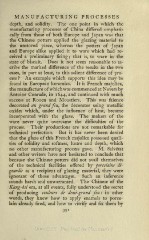Page 477 - Oriental Series Japan and China, Brinkly
P. 477
MANUFACTURING PROCESSES
depth, and solidity. The one point in which the
manufacturing processes of China differed emphati-
cally from those of both Europe and Japan was that
the Chinese potters applied the glazing material to
the unstoved piece, whereas the potters of Japan
and Europe alike applied it to ware which had re-
ceived a preliminary firing ; that is, to ware in the
state of biscuit. Does it not seem reasonable to as-
cribe the marked difference of the results in the two
cases, in part at least, to this salient difference of pro-
cess ? An example which supports this idea may be
found in European keramics. It is French majolica,
the manufacture of which was commenced at Nevers by
Antoine Conrade, in 1644, and continued with much
success at Rouen and Moustiers. This was faience
decorated au grand feu, the decorator using metallic
oxides which, under the influence of heat, became
incorporated with the glaze. The makers of the
ware never quite overcame the difficulties of the
process. Their productions are not remarkable for
technical perfection. But it has never been denied
that the glaze of this French majolica possessed quali-
ties of solidity and softness, lustre and depth, which
no other manufacturing process gave. M. Salvetat
and other writers have not hesitated to conclude that
because the Chinese potters did not avail themselves
of the technical facilities offered by porcelaine de-
gourdie as a recipient of glazing material, they were
ignorant of those advantages. Such an inference
sounds harsh and unwarranted. The Chinese of the
Kang-hsi era, at all events, fully understood the secret
of producing couleurs de demi-grand feu : in other
words, they knew how to apply enamels to porce-
lain already fired, and how to vitrify and fix them by

